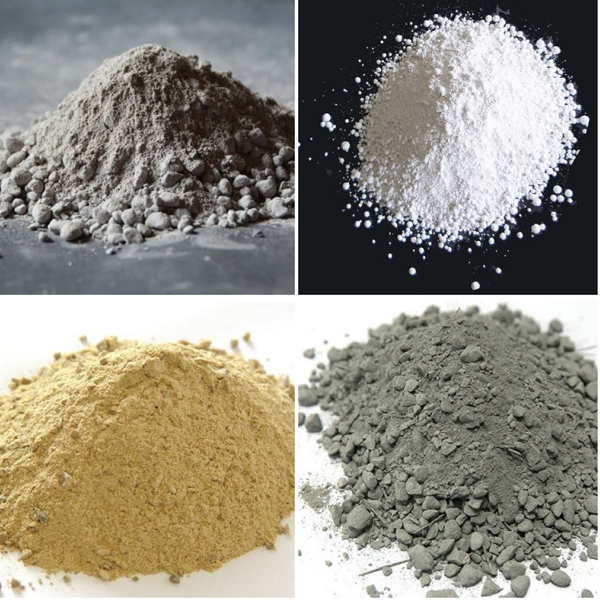Refractory castables (also known as refractory concrete) are of many different types, depending on their aggregate materials, binding agents, and admixtures. This is the commonly used several kinds of refractory castables – silicate cement refractory castables, aluminate refractory castables, water glass refractory castables, and phosphoric acid (or phosphate) refractory castables and other construction essentials are listed below.


1. Preparation Work Before Construction
1.1 Preparation Of Raw Materials
Finished refractory castables should be subject to the necessary technical inspection before construction to confirm that they meet the design requirements before they are put into use.
The refractory castable materials provided by the site should be selected according to the technical requirements proposed by the design. The selected aggregate and powder should be reviewed according to their physical and chemical properties and particle gradation. The selected binding agent should be tested according to its technical requirements.
1.2 Determination Of The Matching Ratio
Finished refractory castables are usually constructed according to the ratio and requirements specified in the construction instructions provided by the manufacturer.
The refractory castables provided by the site should be sampled and test-matched by the test laboratory. In case of meeting the construction requirements, test blocks are made and tested according to the specified items. When the test results meet the design requirements, the final construction ratio can be determined.
1.3 Formulation Of Template
The template for refractory castables construction should be selected according to the characteristics of the project structure and the size of the project, and the types of the template are fixed, hanging, and tooling. The material of formwork is usually steel and wooden mold.
The formwork should meet the following requirements when it is supported:
(1) accurate size, in line with the design provisions.
(2) firm support, formwork combination installation to facilitate construction, lap joints tight, no leakage.
(3) For corrosive or adhesive refractory castables should be set up in the template isolation layer.
(4)The wooden slats used for pre-deposited expansion joints should be fixed firmly to avoid displacement by vibrating.
(5) The template should be painted with protective oil etc. before construction to prevent bonding.
1.4 Production And Installation Of Anchorages
The anchor is generally divided into two kinds of metal and non-metal, one end of which is welded to the furnace shell and the supporting steel frame, and buried in the refractory castables, playing a supporting and connecting role.
The anchorages of refractory castables should be set according to the design, usually metal anchorages are used in low-temperature parts, and ceramic anchorages are used in high-temperature parts.
The metal anchorages are in different forms according to different parts of the furnace structure. The metal anchorages of the furnace wall and vault have several types such as V type, L type, and Y type.
일반적으로, the front end of the metal anchor is buried to 2/3 of the thickness of the furnace wall; the anchor brick is generally exposed to the heating surface.
The installation spacing of metal anchors depends on the thickness and height of the furnace wall. 일반적으로, the horizontal spacing is about 550~600㎜, and the vertical spacing is about 450~500㎜.
When using anchor brick, the spacing of the side wall part is mostly 300~500㎜, and the top part is about 200~300㎜.


2. Construction Conditions
Construction conditions are as follows
(1)According to the construction amount required for the project, choose and install one or several forced mixers. The machine should be kept clean. The machinery installed in position should be qualified by test operation before use.
(2) The construction site should be cleaned in advance and cleaned with water or blown with compressed air if necessary.
(3) Casting material lining with the anchoring device should check the position and welding of metal anchor parts or metal anchor parts-seat of anchored brick.
(4) Check the installation size, firmness, and seam of the template.
Mixing
Mixing is done with the manufacturer’s material use instructions.
3. Pouring And Vibration
The pouring of refractory pouring material should be vibrated in layers by a vibrating machine. The vibrating machine should be inserted vibrator or flat vibrator. Only in special cases, can use manual pounding. When using the insertion-type vibrating rod, the thickness of the pouring layer should not exceed 1.25 times the length of the vibrating rod, when using the flat vibrator, its thickness should not exceed 200mm.
The casting material should be poured continuously, and the next layer of casting material should be poured before the first layer of casting material sets. If the construction gap exceeds its initial setting period, it should be handled according to the requirements of construction joints.
4. Maintenance And De-Molding
The maintenance time and environmental requirements of refractory castables are different due to the different types of varieties.
The maintenance precautions for silicate refractory castables are as follows
1) Silicate refractory castable is suitable for watering maintenance so that the cement in the product forms dehydration and hardening in the process of hydration. The maintenance of high alumina cement castables is especially important because the cement in high alumina cement castables is hydrated and enhanced quickly. And produce a lot of exothermic reactions, easy to make its surface crack.
2) Wet maintenance should be covered and watered after the castables start to harden. Watering times to be able to keep the castables have enough moisture state is appropriate.
3)The heating speed of silicate cement refractory castable for steam maintenance should be 10~15℃/h, and the maximum should not exceed 20℃/h; the cooling speed should not exceed 40℃/h.
Cautions for the maintenance of water-glass castables:
The strength growth of water glass castable is produced in the process of silica gel dehydration. 그러므로, it should be kept in a dry environment, but not in water.
The care precautions of phosphoric acid refractory castables are:
1) Phosphoric acid refractory castables should not be maintained with water or steam but in a dry environment.
2) If the ambient temperature is low, low-temperature drying is required after casting.
